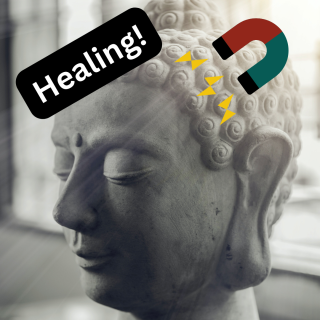Depression
TMS: Stimulating the Brain Back to Health
Understanding Transcranial Magnetic Stimulation.
Posted June 4, 2023 Reviewed by Kaja Perina
Key points
- Transcranial Magnetic Stimulation (TMS) directly stimulates the brain to improve mental health.
- In TMS, multiple magnetic pulses delivered across many treatments can change patterns of brain activity.
- TMS has been approved to treat several mental health conditions, like depression, OCD, and migraines.

Recently, I wrote about new developments in the world of Transcranial Magnetic Stimulation (TMS), a technique for stimulating the brain to treat depression. The discussion was relatively high level, because the new research focused on changes in patterns of brain activity that occur when depressed people received this treatment. Some feedback I got from readers was that this article was a bit “over their heads”—an indication to me that I didn’t do enough to clearly explain my topic. So I thought I’d give a brief bit of background on TMS treatment in general. It’s only had FDA approval for 15 years, but it’s already had a lot of success in helping people when antidepressant medications don’t work. At my own facility, we’ve been using it for years and had excellent results—people quickly recovering from depression while being treated. You can find a lot of information on TMS online, so hopefully this short description is a good entry-way into your learning more (if you’re interested!).
What is TMS?
TMS is a non-invasive medical procedure that uses magnetic fields to stimulate specific areas of the brain. It involves the use of a device called a TMS coil, which generates brief, focused magnetic pulses that pass through the skull and into the targeted brain regions.
TMS works on the principle of electromagnetic induction. When a strong magnetic field is rapidly turned on and off by the coil, it creates an electric current in nearby brain cells. By carefully controlling the timing and intensity of these magnetic pulses, TMS can change the activity of brain cells in a specific brain area.
During a TMS session, a patient sits in a comfortable chair, and the TMS coil is positioned over the scalp. In the first session, a medical care provider will identify the specific place on the brain that will be stimulated. This is done by sending test pulses to a region of the brain connected to control of body movements. When I did this testing, I was in a big massage chair with my arm raised so that you could see my fingers and thumb. The system identifies the right location—and the right strength of stimulation to deliver—by sending pulses that will make your thumb twitch slightly.
It was a weird feeling to be sitting in a chair, talking to my colleagues, and then see my thumb twitch suddenly on its own. But it didn’t hurt, and the process was relatively quick. Once they found the key location, they saved it in the computer so that we could use it for future treatment. If I were a patient, I would then come back every day for 30 days—or multiple times per day for fewer days, using new systems—for the treatment sessions.
During a treatment session, you would come in, sit in the massage chair, and then have the coil placed in the correct location for your head. Then you just sit quietly while it delivers a treatment. At my facility, we had a DVD player and movies for people to watch while they sat for 20 minutes. That was with our older system. With our newer system, that 20 minutes is reduced to less than 5 minutes, so typically people just sit and make small talk with our TMS coordinator.

How Does TMS Work?
TMS delivers magnetic pulses that pass through the scalp and skull, reaching the brain. This causes small electrical currents to flow in brain cells, which can either increase or decrease their activity, depending on the settings used. Because different areas of the brain are constantly communicating and working together, delivering pulses to one area of the brain can have effects on other areas. That’s what my last post was about: how TMS changes the pattern of communication between different areas of the brain.
TMS works over multiple sessions. Just having one stimulation is not going to get rid of depression. That’s because new patterns of activity in the brain are being learned. The classic expression in neuroscience is “neurons that fire together wire together”—meaning that when brain cells are activated together multiple times, they actively change to become more responsive to each other. What TMS tries to do is change not just brain activity in the moment, when you’re sitting in a massage chair in a nice medical facility. It aims to create lasting changes in how the brain works when you’re out in the real world, interacting with the things that might trigger you to feel depressed. By receiving multiple stimulations, you’re creating a new pattern of connections in the brain that will be strengthened and reinforced—and there for you when you need it outside of the treatment setting.
What Can TMS Do?
The most common use of TMS is for treating depression. That was the first mental health condition it was approved to treat, back in 2008. But TMS research is a hot topic! The FDA has recently approved a faster version of TMS treatment for depression (done in 5 days, as opposed to 30—see my last post); a TMS treatment for obsessive-compulsive disorder (OCD), a TMS treatment for migraines, a TMS treatment to help people quit smoking, and a TMS treatment for anxious depression (e.g. having both anxiety and depression). The FDA has also given “breakthrough device designation”—often a step before full approval—to a TMS treatment for bipolar disorder. As we learn more about the brain and brain stimulation, scientists will likely find even more ways TMS can help treat mental health problems.
For a more personal perspective on TMS treatment, I’d recommend the book “Switched On” by John Elder Robinson. Robinson, who is on the autism spectrum, gives a first hand account of receiving experimental TMS treatment. The treatment didn’t change his status as a person on the spectrum, but he did credit it with helping him to better connect with his own feelings—and the feelings of those around him. Reading about the kinds of profound changes TMS can induce in someone gives a sense of the power that directly stimulating the brain can have. We’re in an exciting time for neuroscience and mental health—let’s keep learning together!


